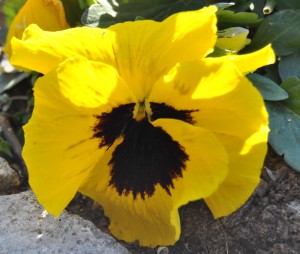Un jardín de nomeolvides Posted by Magda on Mar 22, 2012 in Spanish Vocabulary
Se acerca la primavera, y la tierra comienza a despertar. Hoy voy a compartir otro de mis hobbies, la jardinería. Muchas plantas aún no comenzaron a florecer. Sin embargo si podemos ya disfrutar de la sencillez y el brillante colorido del pensamiento, o viola. ¿Lo conocéis?
El pensamiento tiene hojas con forma de corazón y margen dentado, y sus flores poseen pétalos aterciopelados. El lenguaje de las flores es muy interesante: los pensamientos silvestres tienen la “fama” de atraer el amor. Cada color tiene un significado distinto: la blanca ‘candor’; la violeta ‘modestia’; y si adornan a la flor tres colores juntos, esta invita al ‘recuerdo’, por lo que también recibe esta flor el nombre de ‘nomeolvides’.
Esta es una planta que necesita luz y sol, pero muy resistente, por lo que es común encontrarla adornando parques y jardines durante el invierno. No necesita que se riegue en abundancia. Eso sí, deberemos estar atentos para evitar las plagas de pulgones, que disfrutan atacándola. Un pequeño truco: si cortamos las flores marchitas, el resto florecerán mejor. Mientras comienzan a brotar las plantas bulbosas propias de la primavera, de las que hablaremos otro día si os parece, nos quedaremos disfrutando de esta sencilla y bella flor. La que os dejo hoy tiene la suerte de lucir en los parterres de Aranjuez, un palacio real cerca de Madrid.
Spring is coming, and the land begins to wake up. Today I am going to share one of my hobbies with you, gardening. Many plants didn’t still begin to bloom. Nevertheless, we can already enjoy the simplicity and the brilliant colour of the pansy. Do you know it? The pansy has heart form leaves and toothed margin, and its flowers possess velvet petals. The language of the flowers is very interesting: the wild pansies have the “reputation” of attracting love. Every colour has a different meaning: white ‘candour’; the violet ‘modesty’; and if the flower is adorned with three colours, it brings memories back, that’s why this flower gets the name of ‘forget-me-not’.
This plant needs light and sun, but very resistant, so it is common to see it adorning parks and gardens during the winter. It is not necessary to water it abundantly. But we will have to pay attention to avoid the plagues of plant louses, which enjoy attacking it. A small trick: if you cut the withered flowers, the rest will bloom better. While the bulb spring plants begin to sprout, we will speak about them another day if you like, we will continue enjoying this simple and beautiful flower. The one I leave today is lucky to flaunt in Aranjuez’s flowerbeds, a royal palace near Madrid.

Build vocabulary, practice pronunciation, and more with Transparent Language Online. Available anytime, anywhere, on any device.





Comments:
andreas:
¡Hola, Magda!
A mí también me gustan mucho las plantas, pero las que me gustan mejor son tropicales. Por lo tanto tengo una cuantas en el piso.
Andreas
Magda:
@andreas ¡Hola Andreas!
A mi también me encantan las plantas tropicales. He intentado tener alguna en casa, pero con los cambios de temperatura que hay en mi ciudad, no he tenido muy buen resultado. Tan solo he conseguido mantener de momento una flor del paraiso, que es preciosa.